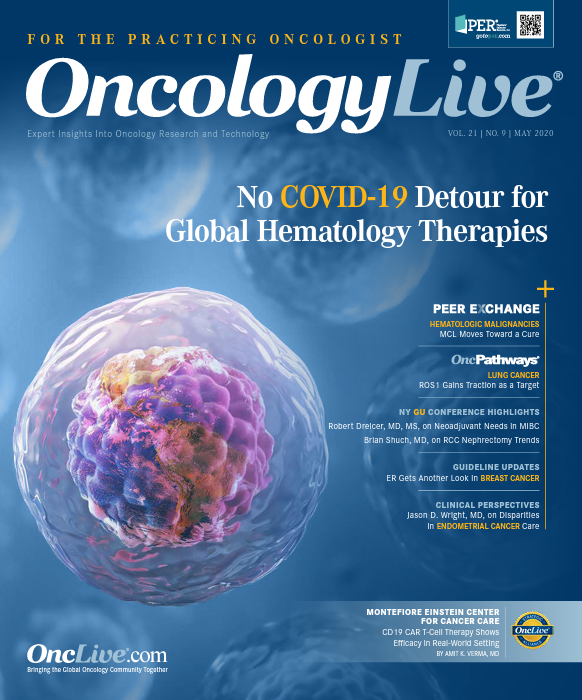COVID-19 Pandemic Exposes Faults in System, But May Prompt Advances in Telehealth and Research
What was simply unimaginable just a few weeks earlier regarding the potential impact of an infectious illness in the United States on jobs, schools, the economy, and personal and family safety has become a stream of daily pronouncements about the severity of the pandemic and how best to respond.
Maurie Markman, MD, editor in chief, is president of Medicine and Science at Cancer Treatment Centers of America and clinical professor of medicine, Drexel University College of Medicine

Maurie Markman, MD
Although so much has been said about the impact that the coronavirus disease 2019 (COVID-19) has had on every aspect of our personal and professional lives, there are several developments that merit close consideration. First, the speed with which chilling new developments have unfolded is simply staggering. Consider, for example, that the March 26 issue of the New England Journal of Medicine included an article on “early transmission dynamics” of a “novel coronavirus-infected pneumonia” in Wuhan, China, that included 425 patients treated for COVID-19 in December 2019 and January 2020.1 This is an amazingly rapid timeline for the collection of clinical data, and the subsequent preparation, submission, peer review, and publication of a meaningful scientific manuscript. Yet, just 4 days later, on March 30, the Johns Hopkins University Center for Systems Science and Engineering reported 782,319 confirmed cases of COVID-19 cases worldwide, resulting in 37,582 deaths.2 In the United States, there were 161,807 cases leading to 2943 deaths.
What was simply unimaginable just a few weeks earlier regarding the potential impact of an infectious illness in the United States on jobs, schools, the economy, and personal and family safety has become a stream of daily pronouncements—some quite conflicting—about the severity of the pandemic and how best to respond. As this commentary is being written, much of the country is under a “lockdown” with the expectation that our society will be experiencing far worse than what has been seen to date before the situation gradually improves.
COVID-19 Exposes Shortcomings
Scenes of the impact of this devastating viral infection on the health care system, hospitals, providers, patients, and their families are simply heart wrenching. As someone who has been a physician in the US health system for more than 4 decades, I find it simply unfathomable that we are observing widespread shortages of critical supplies such as masks, ventilators, hospital beds, and essential testing. Is this really the United States of America?
Further, although this is certainly not the time for blame, recriminations, or focusing on critical “lessons learned” so our health care system can be in a far better position to respond to the introduction of a novel highly infectious agent in the future, it must be acknowledged that there are very serious concerns with our national scientific and health regulatory infrastructure, highlighted in an investigative report in the New York Times, that need to be reviewed and fixed.3 These concerns include the possibly irrational focus by the Centers for Disease Control and Prevention on the development of an “in-house” test for the presence of this virus when other countries elected to utilize an existing effective testing strategy. Additional issues include distressing bureaucratic delays related to the approval process for state health agencies, commercial diagnostic companies, and academic centers to develop sensitive tests with rapid readout (1 hour or less) that could be produced very quickly and in massive quantities. Finally, there was the startling observation that the promised “national stockpiles” of critical supplies that might be used by health care workers and hospitals in a pandemic were woefully inadequate for the task at hand.
Fortunately, 1 important development in this evolving crisis is the role being played by objective scientific expertise in guiding critical decisions at the national and state levels. As difficult as the situation is today, it is encouraging to see individuals with internationally recognized credentials and highly relevant experience such as Anthony S. Fauci, MD, sharing the podium with our nation’s political leaders in describing the nature and severity of what we as a nation are facing. Importantly, these individuals are also reassuring the public that the extraordinary scientific community in our nation and in many other countries, which includes the remarkable ingenuity and skills among scientists at industry partners in large and small pharmaceutical, biotech, and diagnostic companies, is working 24-7 to find answers. These efforts include research into treatments and vaccines, producing essential supplies, and assisting truly heroic health care providers and governmental agencies in “flattening the cure,” saving lives, and helping prevent serious illness.
Telehealth and Research Make Strides
Finally, several specific developments that have characterized the nation’s full-court press to contain and ultimately control this virus are noteworthy. The first is the governmental decision to essentially eliminate—at least during the pandemic—increasingly problematic and, to be frank, inane but long-standing bureaucratic regulations related to telehealth.4
What was the rationale, for example, for requiring that a trained and licensed clinician in the United States in the year 2020 must have a license in the state where the patient is located in order to provide telehealth medical care/advice to that individual? Although this question cannot be answered here, one can only hope that it will be very loudly asked before a decision is made to revert to the caveman era of rules in force before COVID-19, which prevented providers from optimally employing increasingly useful, patient-friendly, highly cost-effective, and secure technology.
It is also important to highlight the impressive speed that critical clinical trials related to the search for therapeutics and vaccines for COVID-19 have been approved by regulatory agencies, subsequently initiated by pharmaceutical and biotech sponsors, and conducted in academic and community centers across the country and world. Why can this experience not serve as a model for future drug development, including the cancer arena, when the COVID-19 pandemic finally becomes something that we, our families, and future generations remember as an event which, like World War II, characterizes the true strength of America?
References
- Li Q, Guan X, Wu P, et al. Early transmission dynamics in Wuhan, China, of novel coronavirus-infected pneumonia. N Engl J Med. 2020;382(13):1199-1207. doi:10.1056/NEJMoa2001316
- Johns Hopkins University Center for Systems Science and Engineering. Coronavirus daily update. Wall Street Journal. March 30, 2020.
- Shear MD, Goodnough A, Kaplan S, Fink S, Thomas K, Weiland N. Testing blunders cost vital month in U.S. virus fight. New York Times. March 29, 2020;A1.
- Robeznieks A. Key changes made to telehealth guidelines to boost COVID-19 care. American Medical Association website. Published March 19, 2020. Accessed April 13. 2020. ama-assn.org/delivering-care/ public-health/key-changes-made-telehealth-guidelines-boost-covid-19-care




